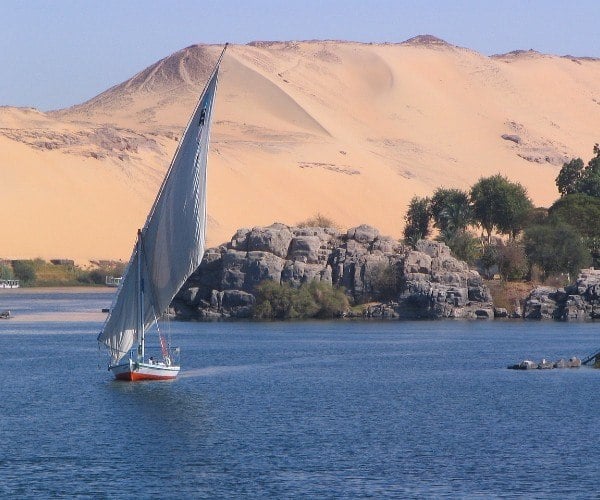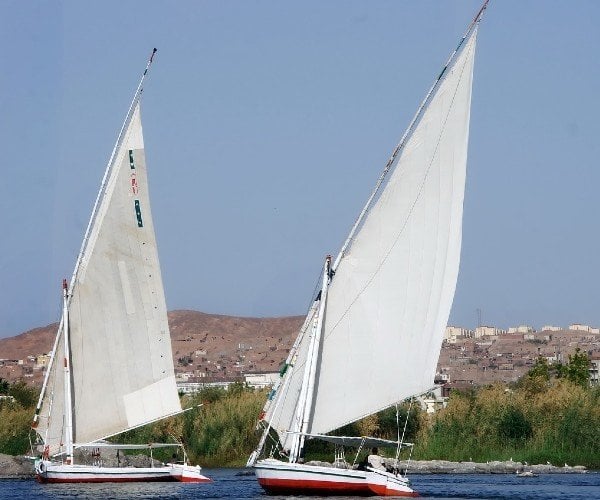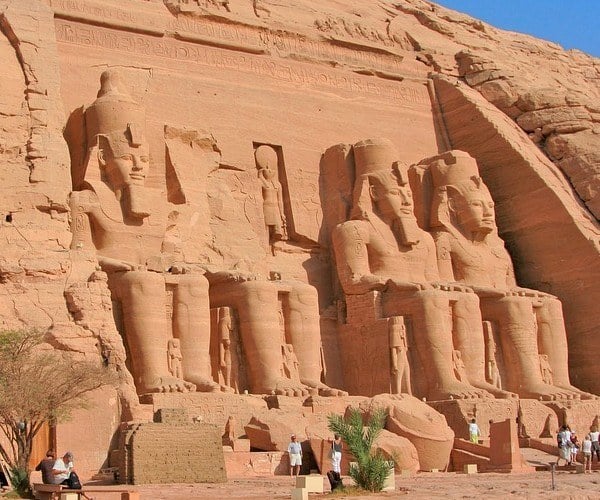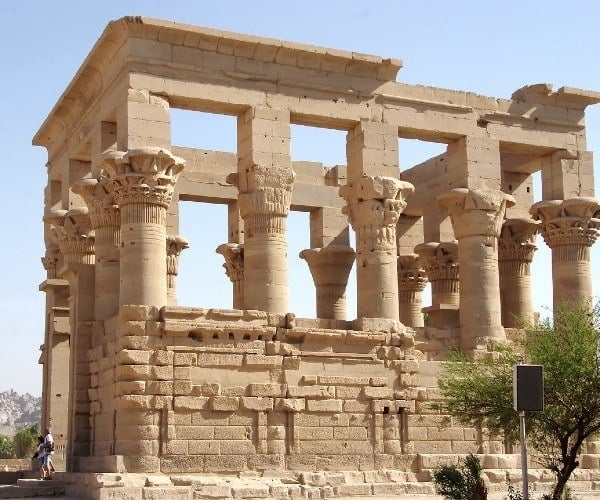6 attractions you can’t miss in Aswan
If you’ve just arrived from busy Luxor or Cairo, Aswan is a laid-back and welcoming town that offers a peaceful break. Aswan is spread out along the banks of the Nile and is the ideal starting point for seeing the temples, monuments, and other tourist attractions in the southern regions of Upper Egypt, as well as the completely different Nubian culture of the region.
Ramses II’s enormous temples at Abu Simbel, the temple on the island of Philae, and the Temple of Kom Ombo are all within easy day trips of Aswan, which is also the closest town to all of them.
The finest way to see Aswan’s charms is to board a felucca, a traditional sailboat, and explore the city from the water, where Aswan was once a significant commerce hub. The river here is filled with islands that are home to charming mud-brick Nubian settlements and is surrounded by enormous sand dunes from the West Bank.
Everything is really photogenic, especially around twilight when the river shimmers with the setting sun and hundreds of lateen-sailed feluccas take to the water. Aswan is one of the top destinations in Egypt for serious photographers looking to capture iconic Nile vistas.
1. Elephantine Island
There are numerous old ruins on Elephantine Island that are worth exploring. The temple of Khnum is completely destroyed, and all that is left of it is a few scattered stones and broken columns. However, you can still see the temple’s square granite gateway, which was found by the German Swiss excavation team while they were looking for the remains of the new kingdom on the island. A restored temple called Satis temple can be seen in the island’s north. On top of the ruins of the middle kingdom, the temple was erected during the reign of Queen Hatshepsut and King Tuthmose III.

A highly interesting highlight is the island-based Aswan Museum. Mummies and statues, as well as relics dating from the predynastic through the Roman and Byzantine periods, were discovered on the island when it was first established in 1912. The Nilometer, which is said to be among the earliest Nilometers, is located in front of the museum and was used by the ancient Egyptians to gauge Nile floods. The massive rocks on the shores of the island, bearing the inscriptions of the kings and governors who ruled the island throughout history, are another outstanding characteristic that sets the island apart.
2. Felucca trip
Taking a felucca out on the river to explore Aswan’s sites is the conventional way to do so (traditional lateen-sail boat). Finding a skipper eager to take you on a river tour won’t be difficult. All day, Felucca captains stand around Aswan’s Nile-side corniche and solicit passengers.

A typical two-hour short cruise sails in a loop around the islands in the central Aswan region, offering spectacular views of the city on the east bank, the lush palm-tree-dotted islands, and the rippling desert sands of the west river bank.
Make a half-day or full-day felucca itinerary for longer tours, add a swimming stop along the way, and schedule stops at some of the major Aswan tourist sites, like the Elephantine Island archaeological site, Kitchener’s Island, the Monastery of St. Simeon, and the Tombs of the Nobles on the west bank.
3. Nubian Museum
Anyone interested in the history and culture of both ancient and contemporary Nubia should visit the quite remarkable Nubian Museum in Aswan, one of Egypt’s greatest. With the construction of the Aswan Dam and the emergence of Lake Nasser, the treasures of a civilization that was all but wiped out are documented.
There are many wonderful black-and-white photographs of UNESCO’s amazing project to save Philae Temple and Abu Simbel from the rising waters of the dam, as well as a sizable collection of artifacts from the Kingdom of Kush (ancient Nubia), as well as extensive photographs of the vast array of other monuments that are now lost forever beneath the lake’s waters.
4. Abu Simbel
Choose a trip to Abu Simbel from Aswan if you can only take one day journey there. Built by Ramses II and miraculously preserved from destruction by a UNESCO rescue mission in the 1970s, Abu Simbel is a marvel of both ancient and contemporary engineering.

Everything else in Egypt pales in comparison to the enormous scale of the Great Temple of Ramses II and the Temple of Hathor, which are located on the shores of Lake Nasser. Most visitors arrive at Abu Simbel by tour. Since Abu Simbel lies 280 kilometers south of Aswan, allow three hours for a minibus or private vehicle to carry you there.
IMPORTANT NOTICE:
If you are reading this article anywhere other than on A Luxury Travel Blog, then the chances are that this content has been stolen without permission.
Please make a note of the web address above and contact A Luxury Travel Blog to advise them of this issue.
Thank you for your help in combatting content theft.
5. Philae Temple
One of Upper Egypt’s most alluring structures is the sacred Temple of Isis (also known as Philae Temple), which was a favorite subject of Victorian painters due to the fine workmanship of its reliefs and the magnificent symmetry of its architecture.

Like Abu Simbel, the temple was relocated lock, stock, and barrel from its original location on Philae Island to nearby (higher) Agilika Island, where it is now, thanks to UNESCO’s rescue mission. The island is also home to the Temple of Hathor, the Kiosk of Trajan, and several other structures from the Roman and Byzantine periods. The Temple of Isis, a hub for the ancient cult of Isis, is the principal component of the Philae complex.
6. Monastery of St. Simeon
On the West Bank of the Nile, the stunningly picturesque Monastery of St. Simeon is situated between sand dunes. One of the largest and best-preserved Coptic monasteries in Egypt, it was first established in the 7th century and eventually abandoned in the 13th due to water difficulties.
An aisled basilica occupies most of the monastery’s southern side inside the courtyard. The huge apse, which features three rectangular niches beneath semi-domes, is located at the east end of the wide nave, which was previously covered by two domes. The remnants of a fresco that showed Christ seated between angels can be seen in the middle niche.
Numerous auxiliary structures and little grottoes may be seen to the north and west of the church, while residential areas make up its eastern side.
Aswan is famous for its peaceful setting, rich archaeological monuments, and stunning views of the Nile Valley. It is the ideal winter getaway because of its mild, year-round weather. The city offers beautiful vistas and attractions for those who want to take a felucca trip across the Nile. If you are planning a trip to Aswan, these mentioned attractions are must-see.
Sherif Khalil is Owner of Dunes & Beyond. Dunes & Beyond offers luxury tours, Nile cruises and desert safaris in Egypt.
If you would like to be a guest blogger on A Luxury Travel Blog in order to raise your profile, please contact us.
Did you enjoy this article?
Receive similar content direct to your inbox.


Having spent 2 hours sailing on the Nile around Aswan I’ve got to say that it was one of my most magical travel experiences ever.
Aswan is on my list. I’ve seen it so often as a backdrop in films and as a feature in travel shows. I especially remember it from Death on the Nile.
It never ceases to amaze me at how great a civilisation Egypt created all those years ago.
The sheer scale of the temples in Egypt really gives you pause to reflect on your place in the world, and to marvel at how these structures were able to be built without labor-saving modern techniques. Simply incredible and awe-inspiring.
Love your posts, Sherif! As someone who is interested in sailing, I would so much love the felucca trip!!!
I’m planning a trip to Egypt this year and have been reading through your posts. It sounds like I definitely need to have Aswan on my itinerary, would you agree for a first time visitor?
Thanks John for your comment.
Yes Aswan is a must during Egypt visit, you can add A Nile Cruise from Luxor to Aswan. Please contact our company Dunes & Beyond if you need us to organize your tour